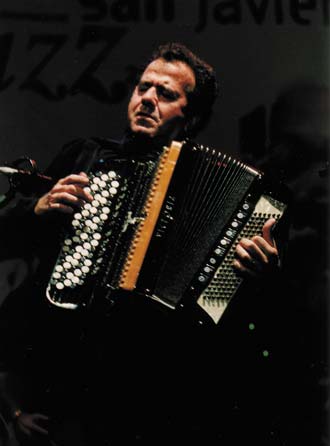
|
Richard Galliano Trio
at the Toronto Jazz Festival |
|
| June 27, 2006 • Harbourfront Centre Theatre • Toronto |
|
|
|
|
|
|
An Accordion in the Family
by Dave Barnes |
| Appearing for the first time at the Toronto Jazz Festival, the Richard Galliano New York Trio completely delighted the Harbourfront Centre Theatre audience. Having been featured to great success in other Canadian Jazz festivals since the mid 90's you might regard us as latecomers to the list of converted.
The New York trio is currently featuring the justly renowned George Mraz on bass and the famously inventive Al Foster on drums. It is an accommodating trio. Galliano has taken on different members over time but this combination has lasted on-and-off through many years and sports the musical familiarity of such long association.
Jazz is both a welcoming and groundbreaking art and sometimes a stickler for protocol and tradition. New instruments and sounds are not always welcomed into the family with the grace you might expect from a form that delights in breaking rules. Adverse reaction to rule-breaking should only apply to those things that get in the way of improvisation and expression.
If your exposure to accordion has been limited to the droning variety you could be excused in allocating accordion and bagpipes to the same space, one largely outside the family of Jazz. Accordion use in Jazz may date from the 1940's but it mostly lacked original repertoire with which to evade the charge of emulating other instruments on their own turf. In general disfavour since the 1960's as the ultimate in un-cool, it has been recovering on merit.
Opposition to electric guitar or harmonica in Jazz is not so distant as we might imagine. These were instruments thought to be too limited in expression – capable only of a plunking or thrumming sameness. Inspired players and heroic devotion converted us so that today these are full members of the Jazz family. With the new sounds came new repertoire to broaden the Jazz taxonomy.
Galliano has reached back into the 1940's traditions of French Musette, taken the reinvigorated Tango of Piazzolla, borrowed orchestral colour from Ravel, injected some of the sonic adventure of Jimi Hendrix and taken in the improvised disciplines of Clifford Brown. Can't imagine such a combination? That is what live performance sets out to accomplish.
|
Thelonius Monk’s "Ruby, My Dear" was a familiar tune taken to new and fascinating places. Galliano's originals "Laurita", "A French Touch" and "Spleen" showed his considerable composition skills. "Bebe", a charming tune by Hermeto Pascoal featured Galliano providing whistled accompaniment to his own playing and Brazilian dance rhythms added to those of Argentinian, Italian and French origin. What was that mid-set item that hinted at Hendrix, The Doors, West Coast acid rock tunings and bluegrass and square dance rhythms? Unannounced, this was a tune of such surprising turns as to induce a search through the Galliano catalogue, to no avail.
Eye contact is fleeting and rare from Galliano as he remains front and centre, eyes mostly closed and in intense concentration leaving Foster to spot and respond instantly to the rapid transitions and neatly executed endings Galliano takes us through. The ears are well occupied.
Harbourfront Centre Theatre is a welcome addition to Festival performance space with its Jazz-friendly acoustics. Wrap-around balconies are especially useful to those of us wanting a close look at technique.
|
|

Richard Galliano |
|
For the visually curious, we watch to see how tones, chords and effects are coached out of a button accordion. George Mraz, maintains a tasteful and sophisticated counter-current both respectful of the repertoire that Galliano brings and the traditions of Jazz form. Al Foster impresses with rhythmic nuance, supplying percussive punctuation to the clever effects being created by Galliano and Mraz.
Unlike the more familiar keyboard-on-its-side design of its cousin, the chromatic button accordion uses a distinct layout of round buttons to present its key choices. In Galliano's hands, this allows for an inventive reach to interesting intervals and chords. Although Galliano has been known to favour a variety of keyed reed instruments, in this two-set concert he explored the scope of this one instrument.
This is acoustic music so small effects loom large. Galliano dropping out accordion stops until it is a whisper of reed and button clicks, Mraz with mere finger touches to strings or Foster with hand drumming, palming of cymbals, rim clicks or drumsticks as claves articulating the mood. Ballads and a lilting Jazz waltz benefit from such sensitivity. But the musical dynamics are fully observed. Robust and insistent multi-reed and rich musette stops are offset with hard-edged and ringing pizzicato bass and open snare accompaniment. Musical interests are served and sonic nuance preserved before ears clamp down due to volume – a lesson to share and use.
Once discovered, this is music to treasure. Until his return, some newly acquired CD's are going to have to suffice.
|
|
|
|
|
|
|



